Strategic Management Report: Aldi's Strategies and Analysis
VerifiedAdded on 2019/12/03
|15
|4447
|407
Report
AI Summary
This report provides a comprehensive strategic analysis of Aldi, a global retail firm known for its low prices and high-quality products. It begins with a company background, outlining Aldi's services and the challenges it faces, such as competition from larger retailers and limited product portfolios. The internal analysis utilizes a SWOT framework to assess Aldi's strengths (low operating costs, international expansion), weaknesses (limited assortment, technological integration), opportunities (investment in promotion, expansion in growing economies), and threats (competition, changing consumer behavior). The report then explores the strategies employed by Aldi, including cost leadership and differentiation, and examines the external environment through a PESTLE analysis, considering political, economic, social, technological, environmental, and legal factors influencing the business. The report concludes with an overview of Aldi's strategic positioning in the competitive retail market.
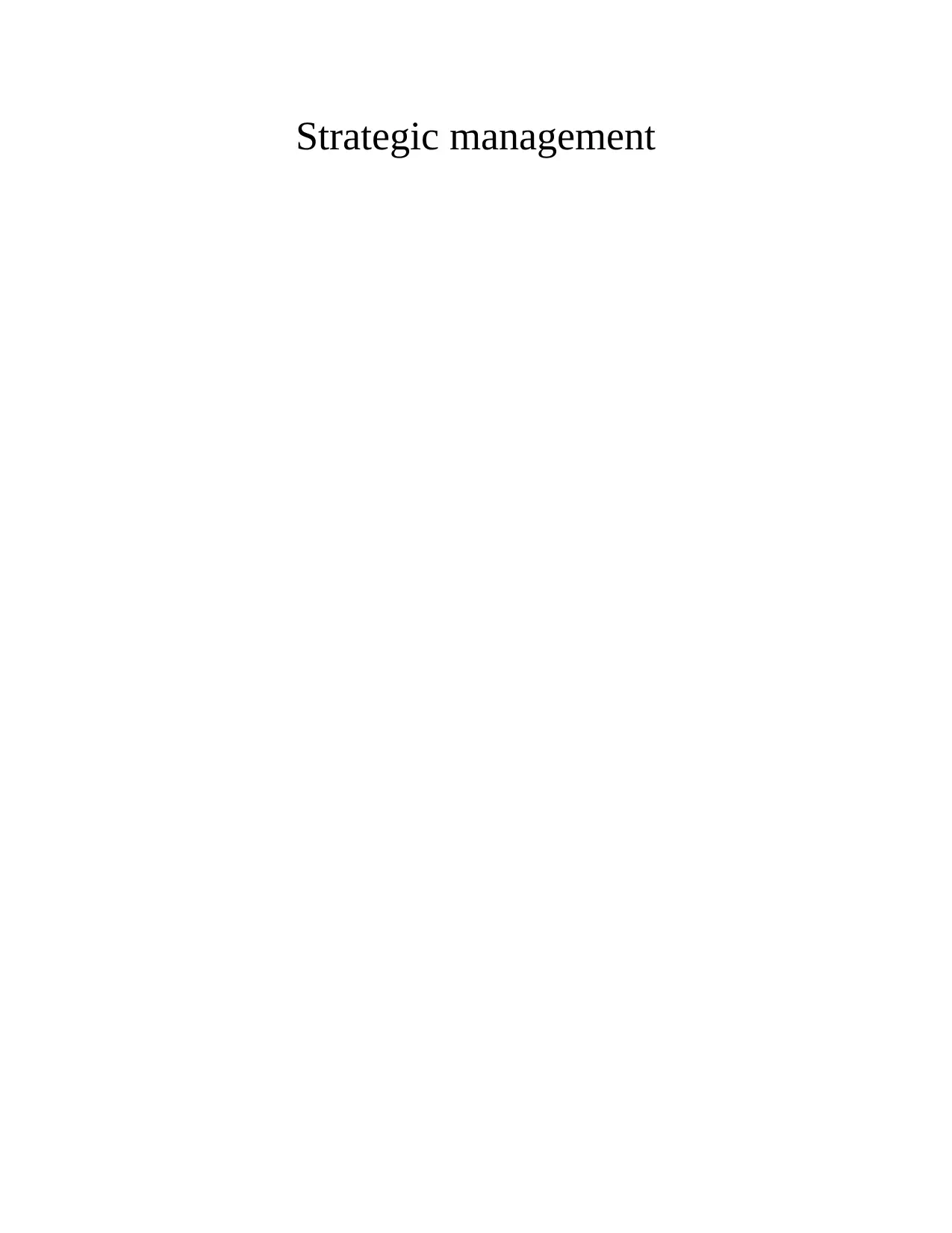
Strategic management
Paraphrase This Document
Need a fresh take? Get an instant paraphrase of this document with our AI Paraphraser
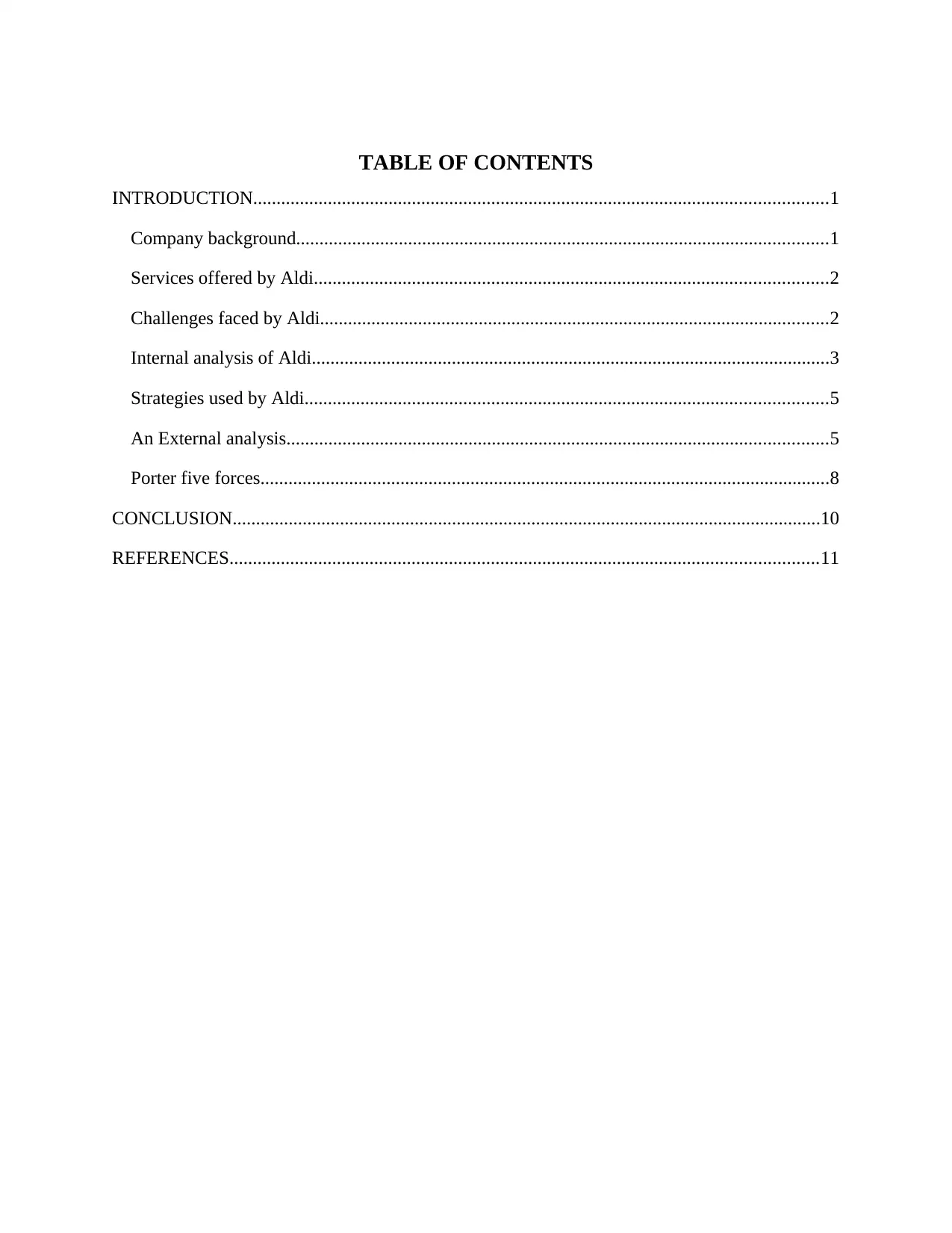
TABLE OF CONTENTS
INTRODUCTION...........................................................................................................................1
Company background..................................................................................................................1
Services offered by Aldi..............................................................................................................2
Challenges faced by Aldi.............................................................................................................2
Internal analysis of Aldi...............................................................................................................3
Strategies used by Aldi................................................................................................................5
An External analysis....................................................................................................................5
Porter five forces..........................................................................................................................8
CONCLUSION..............................................................................................................................10
REFERENCES..............................................................................................................................11
INTRODUCTION...........................................................................................................................1
Company background..................................................................................................................1
Services offered by Aldi..............................................................................................................2
Challenges faced by Aldi.............................................................................................................2
Internal analysis of Aldi...............................................................................................................3
Strategies used by Aldi................................................................................................................5
An External analysis....................................................................................................................5
Porter five forces..........................................................................................................................8
CONCLUSION..............................................................................................................................10
REFERENCES..............................................................................................................................11
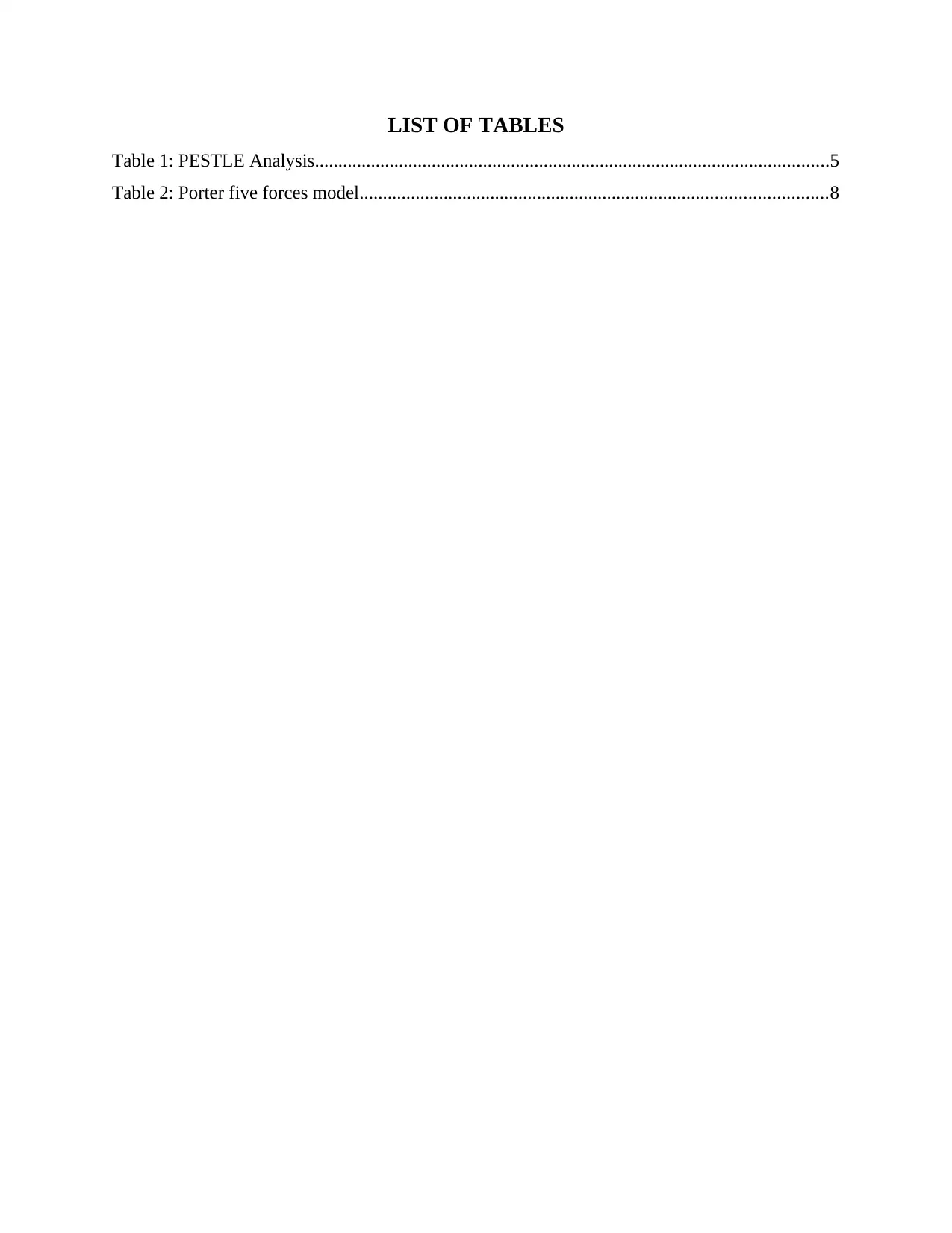
LIST OF TABLES
Table 1: PESTLE Analysis..............................................................................................................5
Table 2: Porter five forces model....................................................................................................8
Table 1: PESTLE Analysis..............................................................................................................5
Table 2: Porter five forces model....................................................................................................8
⊘ This is a preview!⊘
Do you want full access?
Subscribe today to unlock all pages.

Trusted by 1+ million students worldwide
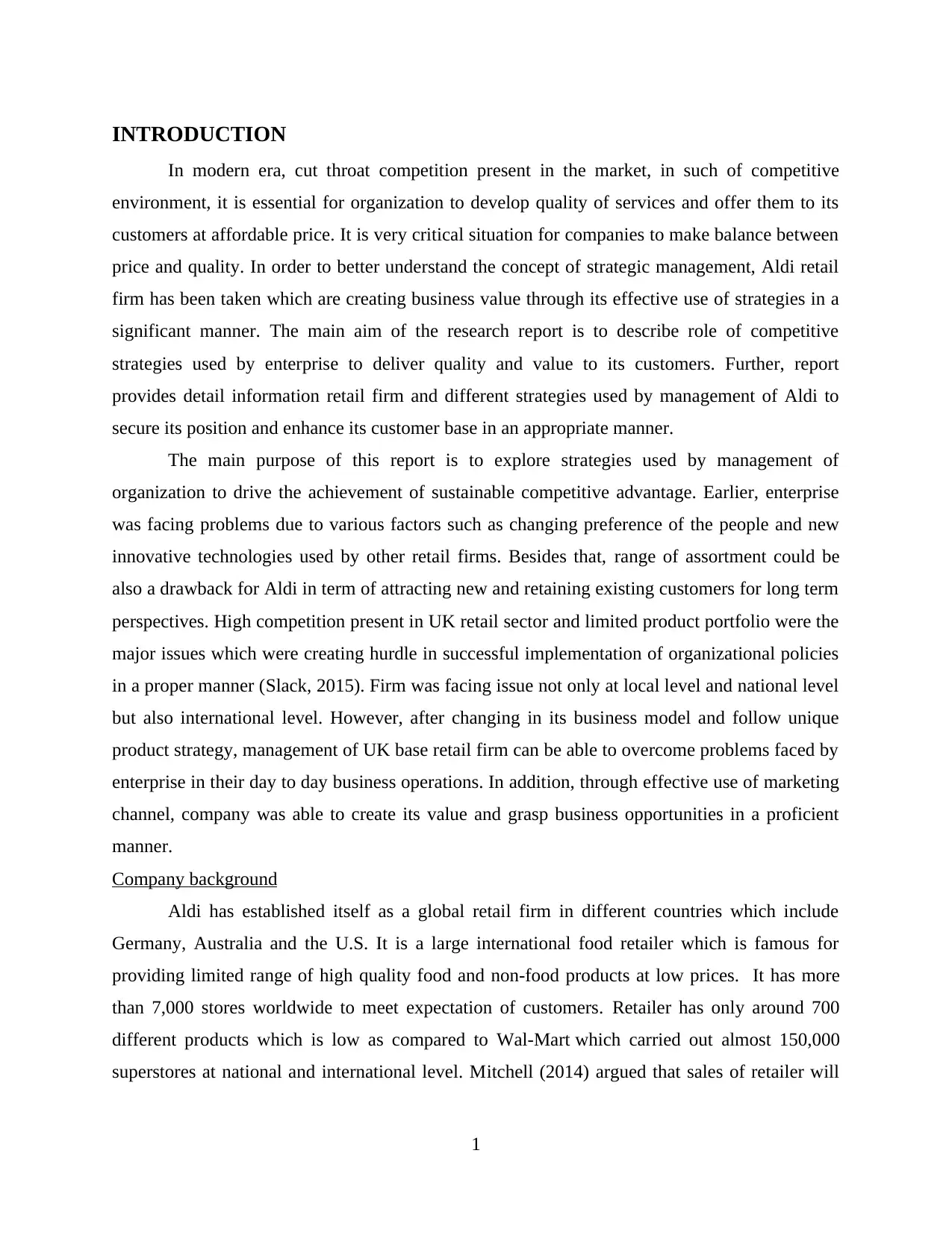
INTRODUCTION
In modern era, cut throat competition present in the market, in such of competitive
environment, it is essential for organization to develop quality of services and offer them to its
customers at affordable price. It is very critical situation for companies to make balance between
price and quality. In order to better understand the concept of strategic management, Aldi retail
firm has been taken which are creating business value through its effective use of strategies in a
significant manner. The main aim of the research report is to describe role of competitive
strategies used by enterprise to deliver quality and value to its customers. Further, report
provides detail information retail firm and different strategies used by management of Aldi to
secure its position and enhance its customer base in an appropriate manner.
The main purpose of this report is to explore strategies used by management of
organization to drive the achievement of sustainable competitive advantage. Earlier, enterprise
was facing problems due to various factors such as changing preference of the people and new
innovative technologies used by other retail firms. Besides that, range of assortment could be
also a drawback for Aldi in term of attracting new and retaining existing customers for long term
perspectives. High competition present in UK retail sector and limited product portfolio were the
major issues which were creating hurdle in successful implementation of organizational policies
in a proper manner (Slack, 2015). Firm was facing issue not only at local level and national level
but also international level. However, after changing in its business model and follow unique
product strategy, management of UK base retail firm can be able to overcome problems faced by
enterprise in their day to day business operations. In addition, through effective use of marketing
channel, company was able to create its value and grasp business opportunities in a proficient
manner.
Company background
Aldi has established itself as a global retail firm in different countries which include
Germany, Australia and the U.S. It is a large international food retailer which is famous for
providing limited range of high quality food and non-food products at low prices. It has more
than 7,000 stores worldwide to meet expectation of customers. Retailer has only around 700
different products which is low as compared to Wal-Mart which carried out almost 150,000
superstores at national and international level. Mitchell (2014) argued that sales of retailer will
1
In modern era, cut throat competition present in the market, in such of competitive
environment, it is essential for organization to develop quality of services and offer them to its
customers at affordable price. It is very critical situation for companies to make balance between
price and quality. In order to better understand the concept of strategic management, Aldi retail
firm has been taken which are creating business value through its effective use of strategies in a
significant manner. The main aim of the research report is to describe role of competitive
strategies used by enterprise to deliver quality and value to its customers. Further, report
provides detail information retail firm and different strategies used by management of Aldi to
secure its position and enhance its customer base in an appropriate manner.
The main purpose of this report is to explore strategies used by management of
organization to drive the achievement of sustainable competitive advantage. Earlier, enterprise
was facing problems due to various factors such as changing preference of the people and new
innovative technologies used by other retail firms. Besides that, range of assortment could be
also a drawback for Aldi in term of attracting new and retaining existing customers for long term
perspectives. High competition present in UK retail sector and limited product portfolio were the
major issues which were creating hurdle in successful implementation of organizational policies
in a proper manner (Slack, 2015). Firm was facing issue not only at local level and national level
but also international level. However, after changing in its business model and follow unique
product strategy, management of UK base retail firm can be able to overcome problems faced by
enterprise in their day to day business operations. In addition, through effective use of marketing
channel, company was able to create its value and grasp business opportunities in a proficient
manner.
Company background
Aldi has established itself as a global retail firm in different countries which include
Germany, Australia and the U.S. It is a large international food retailer which is famous for
providing limited range of high quality food and non-food products at low prices. It has more
than 7,000 stores worldwide to meet expectation of customers. Retailer has only around 700
different products which is low as compared to Wal-Mart which carried out almost 150,000
superstores at national and international level. Mitchell (2014) argued that sales of retailer will
1
Paraphrase This Document
Need a fresh take? Get an instant paraphrase of this document with our AI Paraphraser
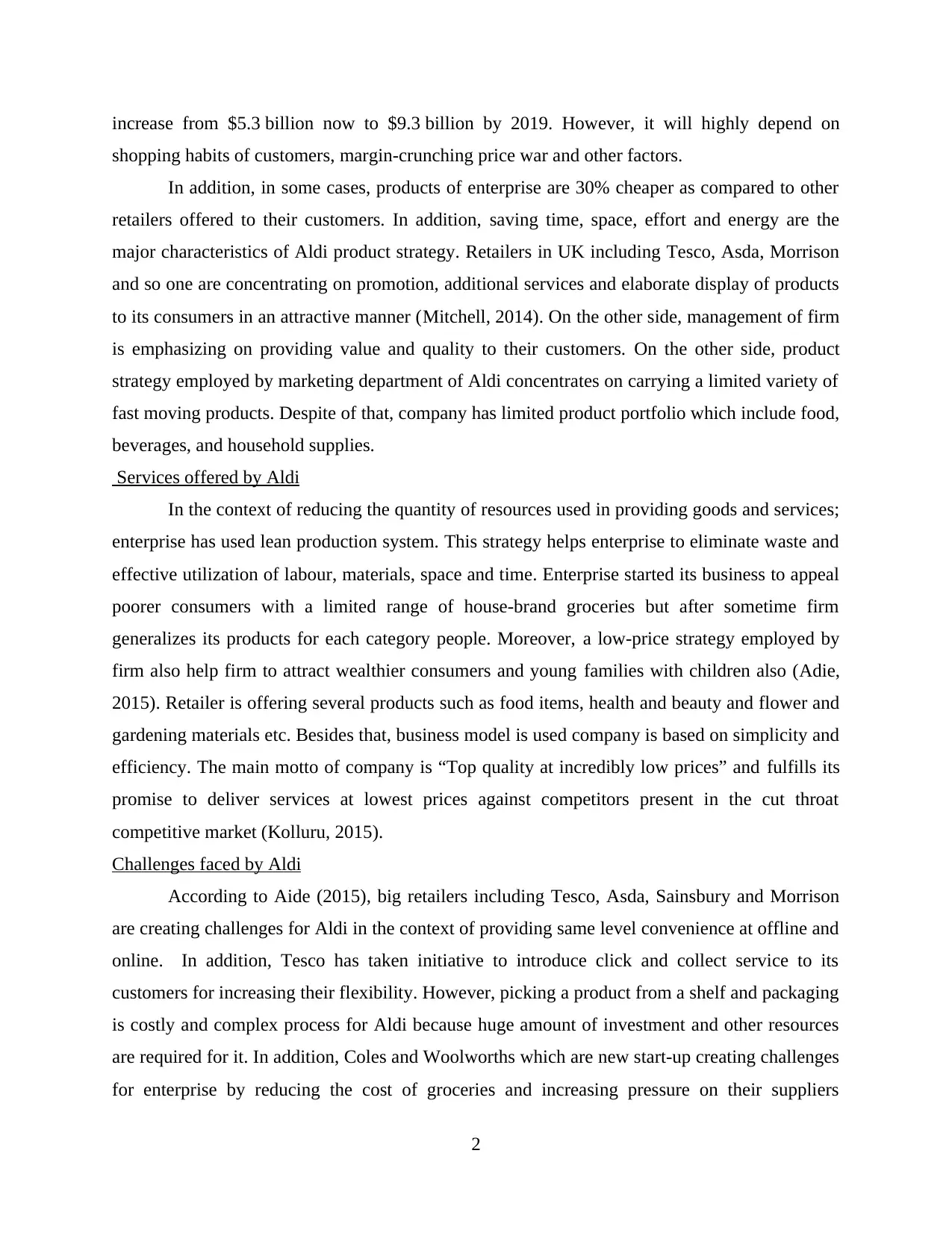
increase from $5.3 billion now to $9.3 billion by 2019. However, it will highly depend on
shopping habits of customers, margin-crunching price war and other factors.
In addition, in some cases, products of enterprise are 30% cheaper as compared to other
retailers offered to their customers. In addition, saving time, space, effort and energy are the
major characteristics of Aldi product strategy. Retailers in UK including Tesco, Asda, Morrison
and so one are concentrating on promotion, additional services and elaborate display of products
to its consumers in an attractive manner (Mitchell, 2014). On the other side, management of firm
is emphasizing on providing value and quality to their customers. On the other side, product
strategy employed by marketing department of Aldi concentrates on carrying a limited variety of
fast moving products. Despite of that, company has limited product portfolio which include food,
beverages, and household supplies.
Services offered by Aldi
In the context of reducing the quantity of resources used in providing goods and services;
enterprise has used lean production system. This strategy helps enterprise to eliminate waste and
effective utilization of labour, materials, space and time. Enterprise started its business to appeal
poorer consumers with a limited range of house-brand groceries but after sometime firm
generalizes its products for each category people. Moreover, a low-price strategy employed by
firm also help firm to attract wealthier consumers and young families with children also (Adie,
2015). Retailer is offering several products such as food items, health and beauty and flower and
gardening materials etc. Besides that, business model is used company is based on simplicity and
efficiency. The main motto of company is “Top quality at incredibly low prices” and fulfills its
promise to deliver services at lowest prices against competitors present in the cut throat
competitive market (Kolluru, 2015).
Challenges faced by Aldi
According to Aide (2015), big retailers including Tesco, Asda, Sainsbury and Morrison
are creating challenges for Aldi in the context of providing same level convenience at offline and
online. In addition, Tesco has taken initiative to introduce click and collect service to its
customers for increasing their flexibility. However, picking a product from a shelf and packaging
is costly and complex process for Aldi because huge amount of investment and other resources
are required for it. In addition, Coles and Woolworths which are new start-up creating challenges
for enterprise by reducing the cost of groceries and increasing pressure on their suppliers
2
shopping habits of customers, margin-crunching price war and other factors.
In addition, in some cases, products of enterprise are 30% cheaper as compared to other
retailers offered to their customers. In addition, saving time, space, effort and energy are the
major characteristics of Aldi product strategy. Retailers in UK including Tesco, Asda, Morrison
and so one are concentrating on promotion, additional services and elaborate display of products
to its consumers in an attractive manner (Mitchell, 2014). On the other side, management of firm
is emphasizing on providing value and quality to their customers. On the other side, product
strategy employed by marketing department of Aldi concentrates on carrying a limited variety of
fast moving products. Despite of that, company has limited product portfolio which include food,
beverages, and household supplies.
Services offered by Aldi
In the context of reducing the quantity of resources used in providing goods and services;
enterprise has used lean production system. This strategy helps enterprise to eliminate waste and
effective utilization of labour, materials, space and time. Enterprise started its business to appeal
poorer consumers with a limited range of house-brand groceries but after sometime firm
generalizes its products for each category people. Moreover, a low-price strategy employed by
firm also help firm to attract wealthier consumers and young families with children also (Adie,
2015). Retailer is offering several products such as food items, health and beauty and flower and
gardening materials etc. Besides that, business model is used company is based on simplicity and
efficiency. The main motto of company is “Top quality at incredibly low prices” and fulfills its
promise to deliver services at lowest prices against competitors present in the cut throat
competitive market (Kolluru, 2015).
Challenges faced by Aldi
According to Aide (2015), big retailers including Tesco, Asda, Sainsbury and Morrison
are creating challenges for Aldi in the context of providing same level convenience at offline and
online. In addition, Tesco has taken initiative to introduce click and collect service to its
customers for increasing their flexibility. However, picking a product from a shelf and packaging
is costly and complex process for Aldi because huge amount of investment and other resources
are required for it. In addition, Coles and Woolworths which are new start-up creating challenges
for enterprise by reducing the cost of groceries and increasing pressure on their suppliers
2
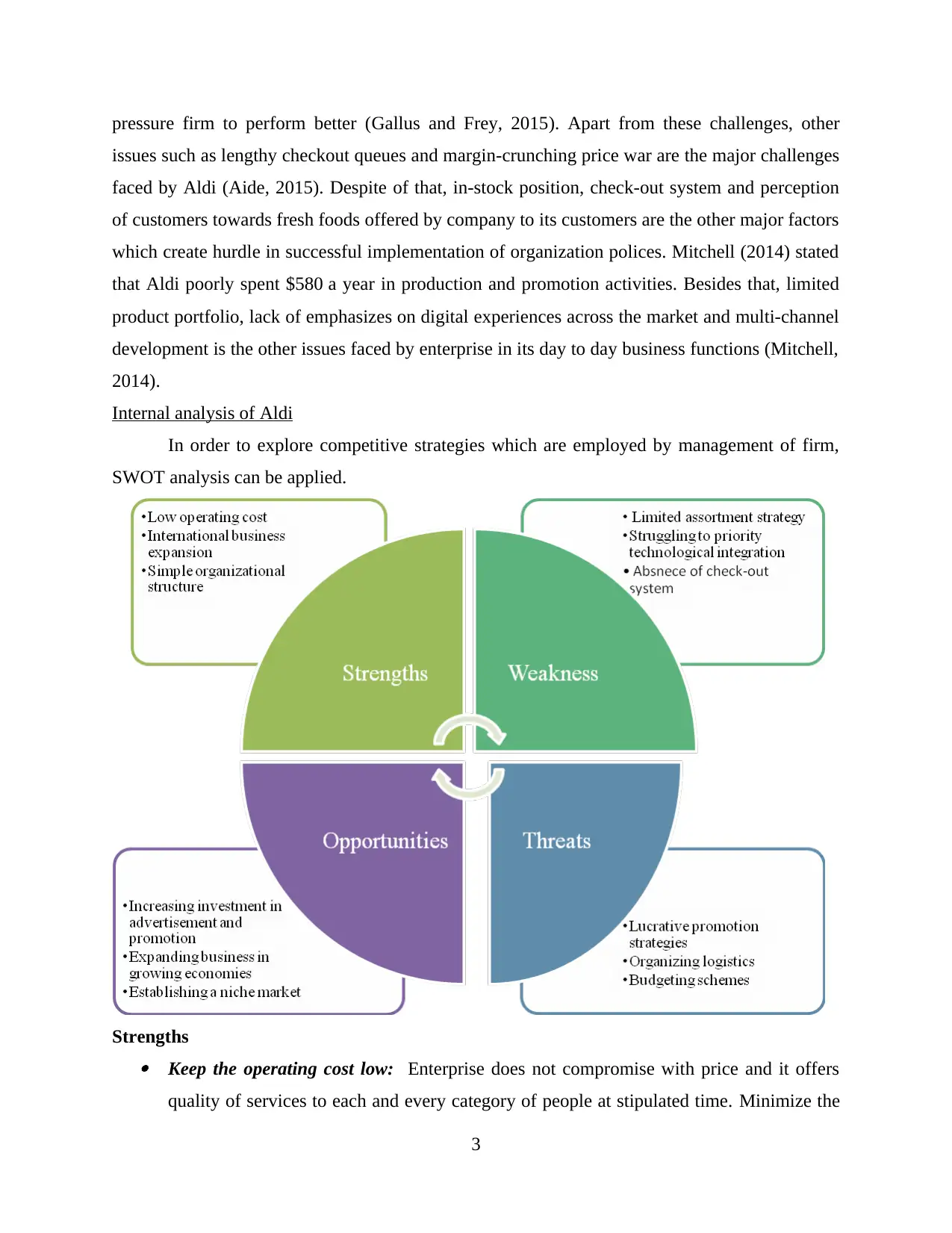
pressure firm to perform better (Gallus and Frey, 2015). Apart from these challenges, other
issues such as lengthy checkout queues and margin-crunching price war are the major challenges
faced by Aldi (Aide, 2015). Despite of that, in-stock position, check-out system and perception
of customers towards fresh foods offered by company to its customers are the other major factors
which create hurdle in successful implementation of organization polices. Mitchell (2014) stated
that Aldi poorly spent $580 a year in production and promotion activities. Besides that, limited
product portfolio, lack of emphasizes on digital experiences across the market and multi-channel
development is the other issues faced by enterprise in its day to day business functions (Mitchell,
2014).
Internal analysis of Aldi
In order to explore competitive strategies which are employed by management of firm,
SWOT analysis can be applied.
Strengths Keep the operating cost low: Enterprise does not compromise with price and it offers
quality of services to each and every category of people at stipulated time. Minimize the
3
issues such as lengthy checkout queues and margin-crunching price war are the major challenges
faced by Aldi (Aide, 2015). Despite of that, in-stock position, check-out system and perception
of customers towards fresh foods offered by company to its customers are the other major factors
which create hurdle in successful implementation of organization polices. Mitchell (2014) stated
that Aldi poorly spent $580 a year in production and promotion activities. Besides that, limited
product portfolio, lack of emphasizes on digital experiences across the market and multi-channel
development is the other issues faced by enterprise in its day to day business functions (Mitchell,
2014).
Internal analysis of Aldi
In order to explore competitive strategies which are employed by management of firm,
SWOT analysis can be applied.
Strengths Keep the operating cost low: Enterprise does not compromise with price and it offers
quality of services to each and every category of people at stipulated time. Minimize the
3
⊘ This is a preview!⊘
Do you want full access?
Subscribe today to unlock all pages.

Trusted by 1+ million students worldwide
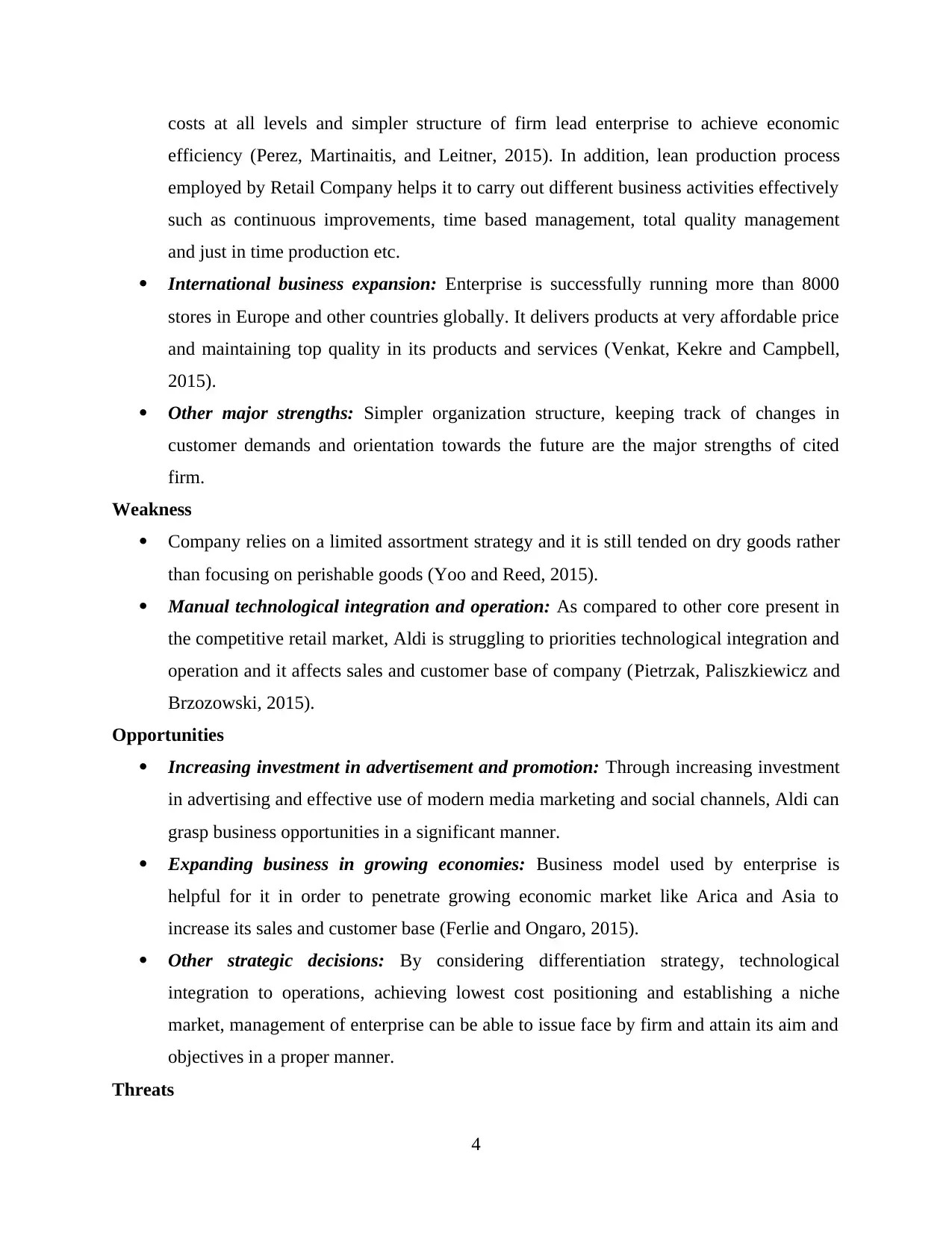
costs at all levels and simpler structure of firm lead enterprise to achieve economic
efficiency (Perez, Martinaitis, and Leitner, 2015). In addition, lean production process
employed by Retail Company helps it to carry out different business activities effectively
such as continuous improvements, time based management, total quality management
and just in time production etc.
International business expansion: Enterprise is successfully running more than 8000
stores in Europe and other countries globally. It delivers products at very affordable price
and maintaining top quality in its products and services (Venkat, Kekre and Campbell,
2015).
Other major strengths: Simpler organization structure, keeping track of changes in
customer demands and orientation towards the future are the major strengths of cited
firm.
Weakness
Company relies on a limited assortment strategy and it is still tended on dry goods rather
than focusing on perishable goods (Yoo and Reed, 2015).
Manual technological integration and operation: As compared to other core present in
the competitive retail market, Aldi is struggling to priorities technological integration and
operation and it affects sales and customer base of company (Pietrzak, Paliszkiewicz and
Brzozowski, 2015).
Opportunities
Increasing investment in advertisement and promotion: Through increasing investment
in advertising and effective use of modern media marketing and social channels, Aldi can
grasp business opportunities in a significant manner.
Expanding business in growing economies: Business model used by enterprise is
helpful for it in order to penetrate growing economic market like Arica and Asia to
increase its sales and customer base (Ferlie and Ongaro, 2015).
Other strategic decisions: By considering differentiation strategy, technological
integration to operations, achieving lowest cost positioning and establishing a niche
market, management of enterprise can be able to issue face by firm and attain its aim and
objectives in a proper manner.
Threats
4
efficiency (Perez, Martinaitis, and Leitner, 2015). In addition, lean production process
employed by Retail Company helps it to carry out different business activities effectively
such as continuous improvements, time based management, total quality management
and just in time production etc.
International business expansion: Enterprise is successfully running more than 8000
stores in Europe and other countries globally. It delivers products at very affordable price
and maintaining top quality in its products and services (Venkat, Kekre and Campbell,
2015).
Other major strengths: Simpler organization structure, keeping track of changes in
customer demands and orientation towards the future are the major strengths of cited
firm.
Weakness
Company relies on a limited assortment strategy and it is still tended on dry goods rather
than focusing on perishable goods (Yoo and Reed, 2015).
Manual technological integration and operation: As compared to other core present in
the competitive retail market, Aldi is struggling to priorities technological integration and
operation and it affects sales and customer base of company (Pietrzak, Paliszkiewicz and
Brzozowski, 2015).
Opportunities
Increasing investment in advertisement and promotion: Through increasing investment
in advertising and effective use of modern media marketing and social channels, Aldi can
grasp business opportunities in a significant manner.
Expanding business in growing economies: Business model used by enterprise is
helpful for it in order to penetrate growing economic market like Arica and Asia to
increase its sales and customer base (Ferlie and Ongaro, 2015).
Other strategic decisions: By considering differentiation strategy, technological
integration to operations, achieving lowest cost positioning and establishing a niche
market, management of enterprise can be able to issue face by firm and attain its aim and
objectives in a proper manner.
Threats
4
Paraphrase This Document
Need a fresh take? Get an instant paraphrase of this document with our AI Paraphraser
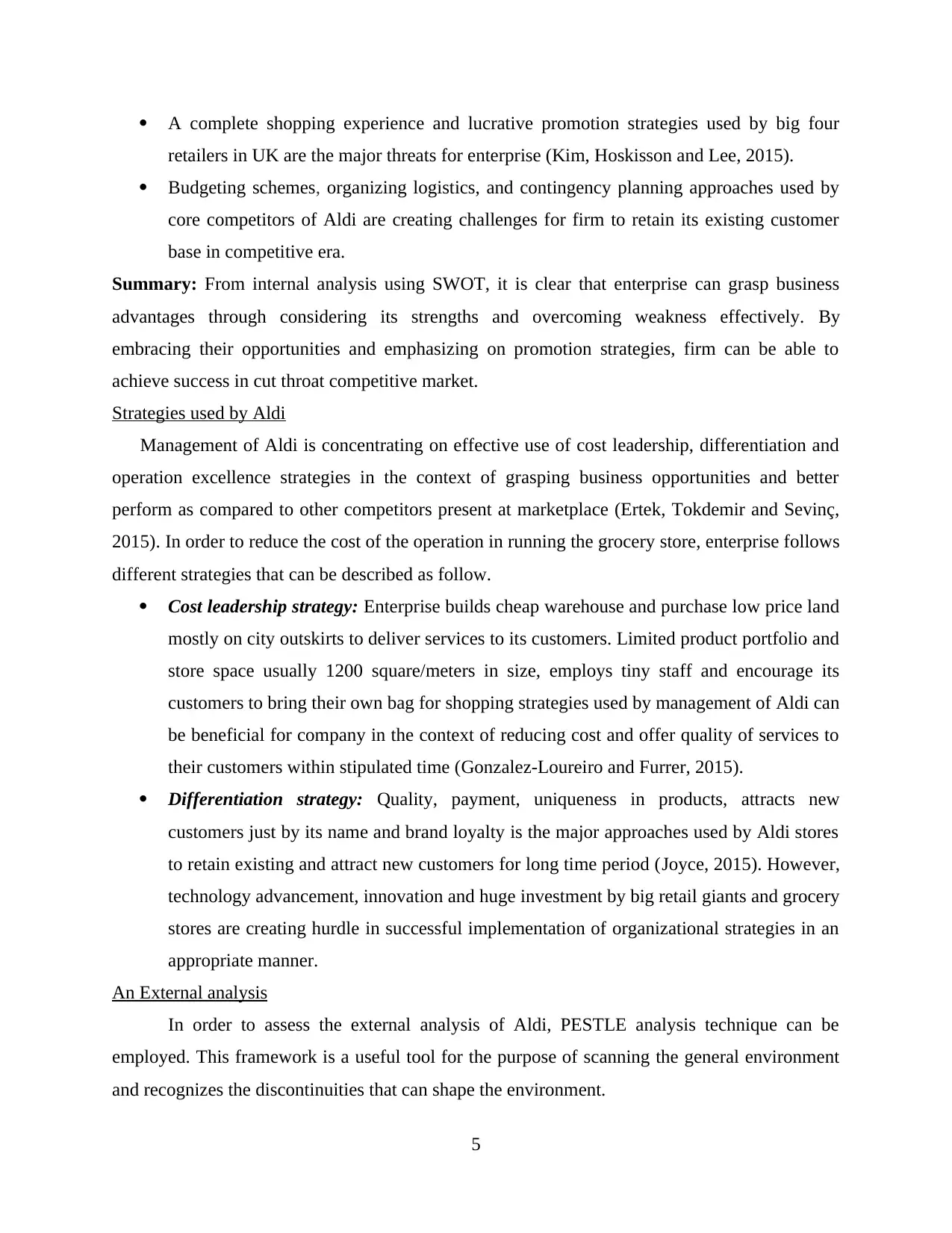
A complete shopping experience and lucrative promotion strategies used by big four
retailers in UK are the major threats for enterprise (Kim, Hoskisson and Lee, 2015).
Budgeting schemes, organizing logistics, and contingency planning approaches used by
core competitors of Aldi are creating challenges for firm to retain its existing customer
base in competitive era.
Summary: From internal analysis using SWOT, it is clear that enterprise can grasp business
advantages through considering its strengths and overcoming weakness effectively. By
embracing their opportunities and emphasizing on promotion strategies, firm can be able to
achieve success in cut throat competitive market.
Strategies used by Aldi
Management of Aldi is concentrating on effective use of cost leadership, differentiation and
operation excellence strategies in the context of grasping business opportunities and better
perform as compared to other competitors present at marketplace (Ertek, Tokdemir and Sevinç,
2015). In order to reduce the cost of the operation in running the grocery store, enterprise follows
different strategies that can be described as follow.
Cost leadership strategy: Enterprise builds cheap warehouse and purchase low price land
mostly on city outskirts to deliver services to its customers. Limited product portfolio and
store space usually 1200 square/meters in size, employs tiny staff and encourage its
customers to bring their own bag for shopping strategies used by management of Aldi can
be beneficial for company in the context of reducing cost and offer quality of services to
their customers within stipulated time (Gonzalez-Loureiro and Furrer, 2015).
Differentiation strategy: Quality, payment, uniqueness in products, attracts new
customers just by its name and brand loyalty is the major approaches used by Aldi stores
to retain existing and attract new customers for long time period (Joyce, 2015). However,
technology advancement, innovation and huge investment by big retail giants and grocery
stores are creating hurdle in successful implementation of organizational strategies in an
appropriate manner.
An External analysis
In order to assess the external analysis of Aldi, PESTLE analysis technique can be
employed. This framework is a useful tool for the purpose of scanning the general environment
and recognizes the discontinuities that can shape the environment.
5
retailers in UK are the major threats for enterprise (Kim, Hoskisson and Lee, 2015).
Budgeting schemes, organizing logistics, and contingency planning approaches used by
core competitors of Aldi are creating challenges for firm to retain its existing customer
base in competitive era.
Summary: From internal analysis using SWOT, it is clear that enterprise can grasp business
advantages through considering its strengths and overcoming weakness effectively. By
embracing their opportunities and emphasizing on promotion strategies, firm can be able to
achieve success in cut throat competitive market.
Strategies used by Aldi
Management of Aldi is concentrating on effective use of cost leadership, differentiation and
operation excellence strategies in the context of grasping business opportunities and better
perform as compared to other competitors present at marketplace (Ertek, Tokdemir and Sevinç,
2015). In order to reduce the cost of the operation in running the grocery store, enterprise follows
different strategies that can be described as follow.
Cost leadership strategy: Enterprise builds cheap warehouse and purchase low price land
mostly on city outskirts to deliver services to its customers. Limited product portfolio and
store space usually 1200 square/meters in size, employs tiny staff and encourage its
customers to bring their own bag for shopping strategies used by management of Aldi can
be beneficial for company in the context of reducing cost and offer quality of services to
their customers within stipulated time (Gonzalez-Loureiro and Furrer, 2015).
Differentiation strategy: Quality, payment, uniqueness in products, attracts new
customers just by its name and brand loyalty is the major approaches used by Aldi stores
to retain existing and attract new customers for long time period (Joyce, 2015). However,
technology advancement, innovation and huge investment by big retail giants and grocery
stores are creating hurdle in successful implementation of organizational strategies in an
appropriate manner.
An External analysis
In order to assess the external analysis of Aldi, PESTLE analysis technique can be
employed. This framework is a useful tool for the purpose of scanning the general environment
and recognizes the discontinuities that can shape the environment.
5
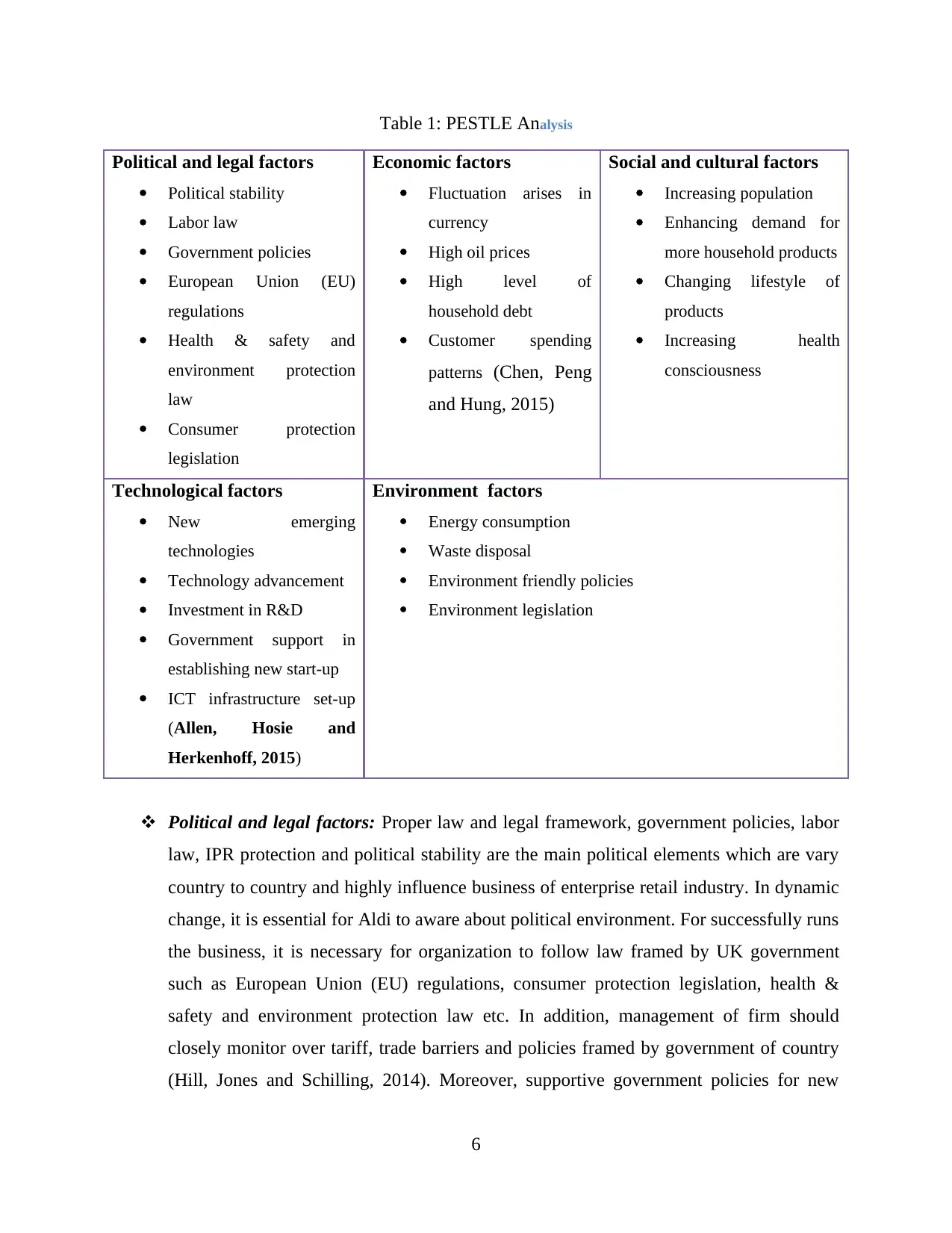
Table 1: PESTLE Analysis
Political and legal factors
Political stability
Labor law
Government policies
European Union (EU)
regulations
Health & safety and
environment protection
law
Consumer protection
legislation
Economic factors
Fluctuation arises in
currency
High oil prices
High level of
household debt
Customer spending
patterns (Chen, Peng
and Hung, 2015)
Social and cultural factors
Increasing population
Enhancing demand for
more household products
Changing lifestyle of
products
Increasing health
consciousness
Technological factors
New emerging
technologies
Technology advancement
Investment in R&D
Government support in
establishing new start-up
ICT infrastructure set-up
(Allen, Hosie and
Herkenhoff, 2015)
Environment factors
Energy consumption
Waste disposal
Environment friendly policies
Environment legislation
Political and legal factors: Proper law and legal framework, government policies, labor
law, IPR protection and political stability are the main political elements which are vary
country to country and highly influence business of enterprise retail industry. In dynamic
change, it is essential for Aldi to aware about political environment. For successfully runs
the business, it is necessary for organization to follow law framed by UK government
such as European Union (EU) regulations, consumer protection legislation, health &
safety and environment protection law etc. In addition, management of firm should
closely monitor over tariff, trade barriers and policies framed by government of country
(Hill, Jones and Schilling, 2014). Moreover, supportive government policies for new
6
Political and legal factors
Political stability
Labor law
Government policies
European Union (EU)
regulations
Health & safety and
environment protection
law
Consumer protection
legislation
Economic factors
Fluctuation arises in
currency
High oil prices
High level of
household debt
Customer spending
patterns (Chen, Peng
and Hung, 2015)
Social and cultural factors
Increasing population
Enhancing demand for
more household products
Changing lifestyle of
products
Increasing health
consciousness
Technological factors
New emerging
technologies
Technology advancement
Investment in R&D
Government support in
establishing new start-up
ICT infrastructure set-up
(Allen, Hosie and
Herkenhoff, 2015)
Environment factors
Energy consumption
Waste disposal
Environment friendly policies
Environment legislation
Political and legal factors: Proper law and legal framework, government policies, labor
law, IPR protection and political stability are the main political elements which are vary
country to country and highly influence business of enterprise retail industry. In dynamic
change, it is essential for Aldi to aware about political environment. For successfully runs
the business, it is necessary for organization to follow law framed by UK government
such as European Union (EU) regulations, consumer protection legislation, health &
safety and environment protection law etc. In addition, management of firm should
closely monitor over tariff, trade barriers and policies framed by government of country
(Hill, Jones and Schilling, 2014). Moreover, supportive government policies for new
6
⊘ This is a preview!⊘
Do you want full access?
Subscribe today to unlock all pages.

Trusted by 1+ million students worldwide
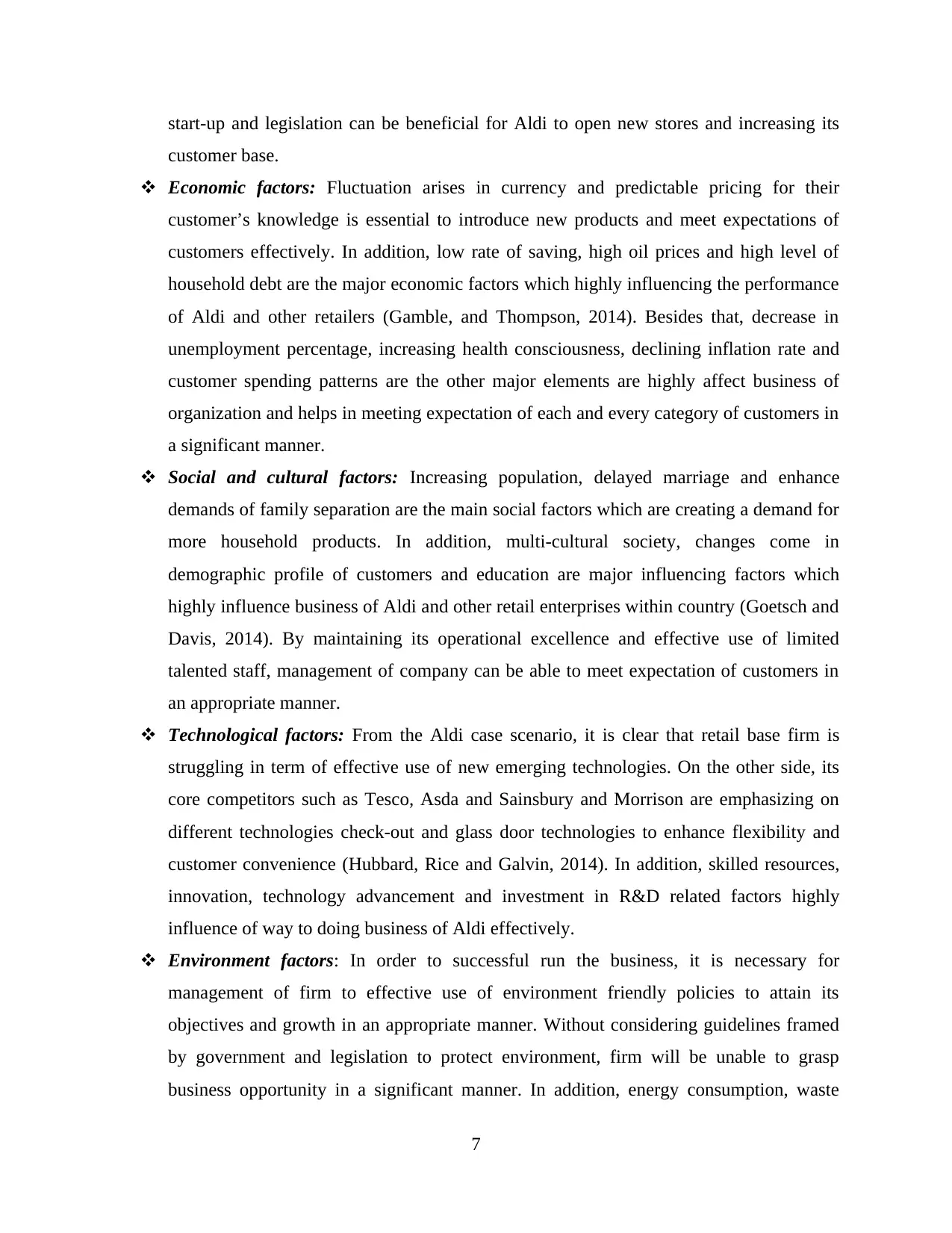
start-up and legislation can be beneficial for Aldi to open new stores and increasing its
customer base.
Economic factors: Fluctuation arises in currency and predictable pricing for their
customer’s knowledge is essential to introduce new products and meet expectations of
customers effectively. In addition, low rate of saving, high oil prices and high level of
household debt are the major economic factors which highly influencing the performance
of Aldi and other retailers (Gamble, and Thompson, 2014). Besides that, decrease in
unemployment percentage, increasing health consciousness, declining inflation rate and
customer spending patterns are the other major elements are highly affect business of
organization and helps in meeting expectation of each and every category of customers in
a significant manner.
Social and cultural factors: Increasing population, delayed marriage and enhance
demands of family separation are the main social factors which are creating a demand for
more household products. In addition, multi-cultural society, changes come in
demographic profile of customers and education are major influencing factors which
highly influence business of Aldi and other retail enterprises within country (Goetsch and
Davis, 2014). By maintaining its operational excellence and effective use of limited
talented staff, management of company can be able to meet expectation of customers in
an appropriate manner.
Technological factors: From the Aldi case scenario, it is clear that retail base firm is
struggling in term of effective use of new emerging technologies. On the other side, its
core competitors such as Tesco, Asda and Sainsbury and Morrison are emphasizing on
different technologies check-out and glass door technologies to enhance flexibility and
customer convenience (Hubbard, Rice and Galvin, 2014). In addition, skilled resources,
innovation, technology advancement and investment in R&D related factors highly
influence of way to doing business of Aldi effectively.
Environment factors: In order to successful run the business, it is necessary for
management of firm to effective use of environment friendly policies to attain its
objectives and growth in an appropriate manner. Without considering guidelines framed
by government and legislation to protect environment, firm will be unable to grasp
business opportunity in a significant manner. In addition, energy consumption, waste
7
customer base.
Economic factors: Fluctuation arises in currency and predictable pricing for their
customer’s knowledge is essential to introduce new products and meet expectations of
customers effectively. In addition, low rate of saving, high oil prices and high level of
household debt are the major economic factors which highly influencing the performance
of Aldi and other retailers (Gamble, and Thompson, 2014). Besides that, decrease in
unemployment percentage, increasing health consciousness, declining inflation rate and
customer spending patterns are the other major elements are highly affect business of
organization and helps in meeting expectation of each and every category of customers in
a significant manner.
Social and cultural factors: Increasing population, delayed marriage and enhance
demands of family separation are the main social factors which are creating a demand for
more household products. In addition, multi-cultural society, changes come in
demographic profile of customers and education are major influencing factors which
highly influence business of Aldi and other retail enterprises within country (Goetsch and
Davis, 2014). By maintaining its operational excellence and effective use of limited
talented staff, management of company can be able to meet expectation of customers in
an appropriate manner.
Technological factors: From the Aldi case scenario, it is clear that retail base firm is
struggling in term of effective use of new emerging technologies. On the other side, its
core competitors such as Tesco, Asda and Sainsbury and Morrison are emphasizing on
different technologies check-out and glass door technologies to enhance flexibility and
customer convenience (Hubbard, Rice and Galvin, 2014). In addition, skilled resources,
innovation, technology advancement and investment in R&D related factors highly
influence of way to doing business of Aldi effectively.
Environment factors: In order to successful run the business, it is necessary for
management of firm to effective use of environment friendly policies to attain its
objectives and growth in an appropriate manner. Without considering guidelines framed
by government and legislation to protect environment, firm will be unable to grasp
business opportunity in a significant manner. In addition, energy consumption, waste
7
Paraphrase This Document
Need a fresh take? Get an instant paraphrase of this document with our AI Paraphraser
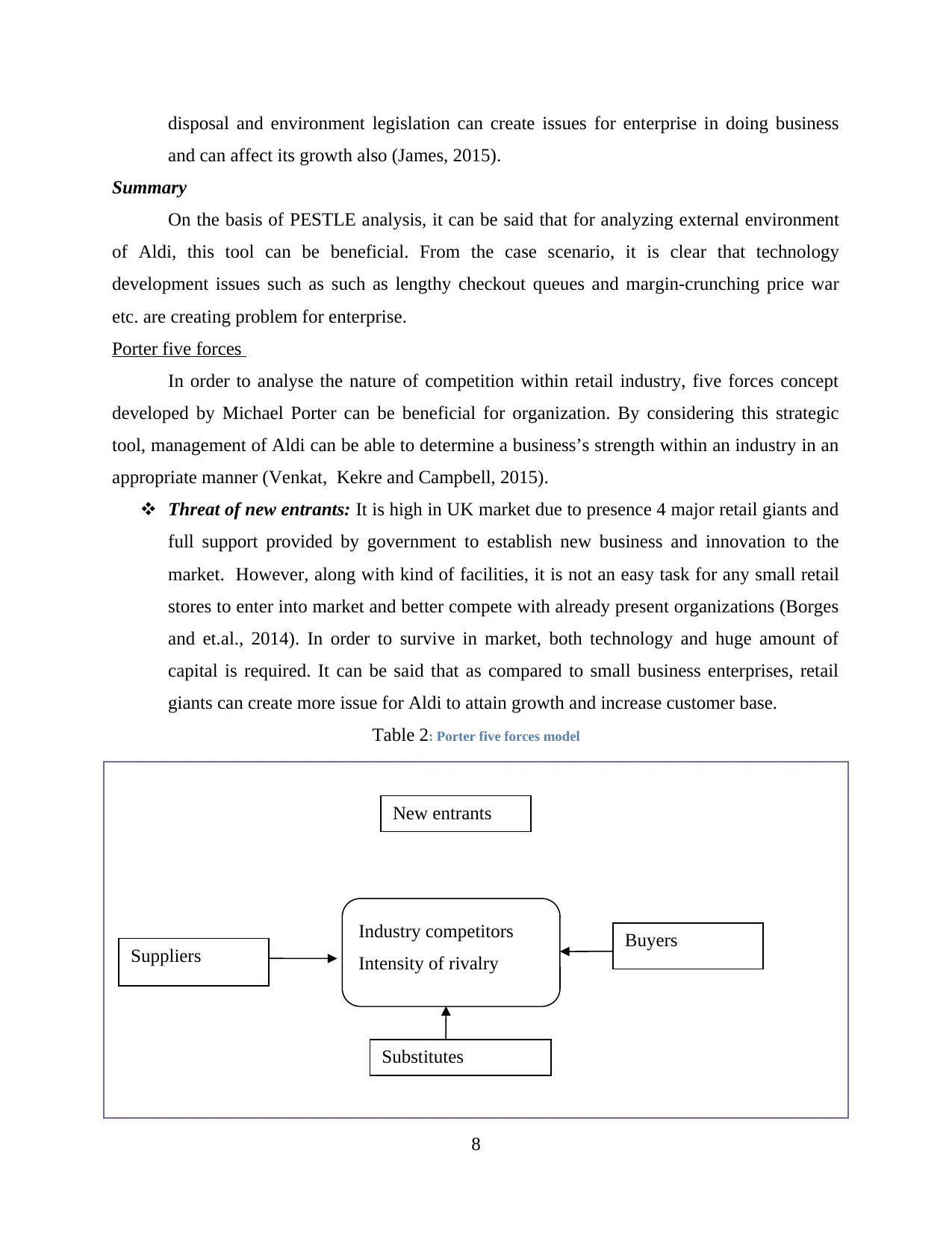
disposal and environment legislation can create issues for enterprise in doing business
and can affect its growth also (James, 2015).
Summary
On the basis of PESTLE analysis, it can be said that for analyzing external environment
of Aldi, this tool can be beneficial. From the case scenario, it is clear that technology
development issues such as such as lengthy checkout queues and margin-crunching price war
etc. are creating problem for enterprise.
Porter five forces
In order to analyse the nature of competition within retail industry, five forces concept
developed by Michael Porter can be beneficial for organization. By considering this strategic
tool, management of Aldi can be able to determine a business’s strength within an industry in an
appropriate manner (Venkat, Kekre and Campbell, 2015).
Threat of new entrants: It is high in UK market due to presence 4 major retail giants and
full support provided by government to establish new business and innovation to the
market. However, along with kind of facilities, it is not an easy task for any small retail
stores to enter into market and better compete with already present organizations (Borges
and et.al., 2014). In order to survive in market, both technology and huge amount of
capital is required. It can be said that as compared to small business enterprises, retail
giants can create more issue for Aldi to attain growth and increase customer base.
Table 2: Porter five forces model
New Entrants Rivalry
Government support to SME’s Retail industry growth
Switching cost Quality service
Product differentiation
Price sensitivity
Cost cutting strategies Standardize products
Low Switching cost Changing needs of customers
Threat of forward integration
Switching cost
8
Suppliers
Industry competitors
Intensity of rivalry
New entrants
Buyers
Substitutes
and can affect its growth also (James, 2015).
Summary
On the basis of PESTLE analysis, it can be said that for analyzing external environment
of Aldi, this tool can be beneficial. From the case scenario, it is clear that technology
development issues such as such as lengthy checkout queues and margin-crunching price war
etc. are creating problem for enterprise.
Porter five forces
In order to analyse the nature of competition within retail industry, five forces concept
developed by Michael Porter can be beneficial for organization. By considering this strategic
tool, management of Aldi can be able to determine a business’s strength within an industry in an
appropriate manner (Venkat, Kekre and Campbell, 2015).
Threat of new entrants: It is high in UK market due to presence 4 major retail giants and
full support provided by government to establish new business and innovation to the
market. However, along with kind of facilities, it is not an easy task for any small retail
stores to enter into market and better compete with already present organizations (Borges
and et.al., 2014). In order to survive in market, both technology and huge amount of
capital is required. It can be said that as compared to small business enterprises, retail
giants can create more issue for Aldi to attain growth and increase customer base.
Table 2: Porter five forces model
New Entrants Rivalry
Government support to SME’s Retail industry growth
Switching cost Quality service
Product differentiation
Price sensitivity
Cost cutting strategies Standardize products
Low Switching cost Changing needs of customers
Threat of forward integration
Switching cost
8
Suppliers
Industry competitors
Intensity of rivalry
New entrants
Buyers
Substitutes
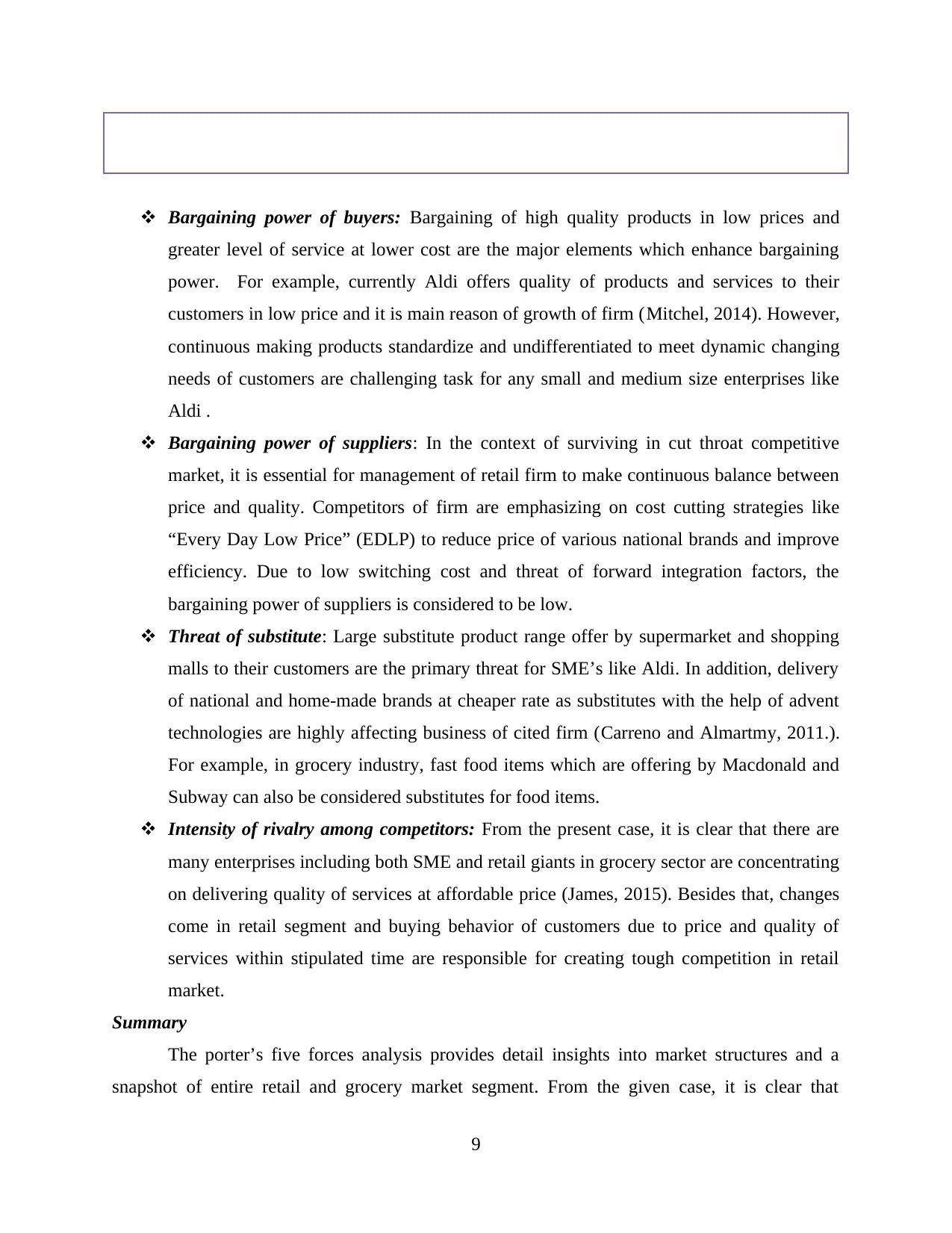
Advent technologies
Bargaining power of buyers: Bargaining of high quality products in low prices and
greater level of service at lower cost are the major elements which enhance bargaining
power. For example, currently Aldi offers quality of products and services to their
customers in low price and it is main reason of growth of firm (Mitchel, 2014). However,
continuous making products standardize and undifferentiated to meet dynamic changing
needs of customers are challenging task for any small and medium size enterprises like
Aldi .
Bargaining power of suppliers: In the context of surviving in cut throat competitive
market, it is essential for management of retail firm to make continuous balance between
price and quality. Competitors of firm are emphasizing on cost cutting strategies like
“Every Day Low Price” (EDLP) to reduce price of various national brands and improve
efficiency. Due to low switching cost and threat of forward integration factors, the
bargaining power of suppliers is considered to be low.
Threat of substitute: Large substitute product range offer by supermarket and shopping
malls to their customers are the primary threat for SME’s like Aldi. In addition, delivery
of national and home-made brands at cheaper rate as substitutes with the help of advent
technologies are highly affecting business of cited firm (Carreno and Almartmy, 2011.).
For example, in grocery industry, fast food items which are offering by Macdonald and
Subway can also be considered substitutes for food items.
Intensity of rivalry among competitors: From the present case, it is clear that there are
many enterprises including both SME and retail giants in grocery sector are concentrating
on delivering quality of services at affordable price (James, 2015). Besides that, changes
come in retail segment and buying behavior of customers due to price and quality of
services within stipulated time are responsible for creating tough competition in retail
market.
Summary
The porter’s five forces analysis provides detail insights into market structures and a
snapshot of entire retail and grocery market segment. From the given case, it is clear that
9
Bargaining power of buyers: Bargaining of high quality products in low prices and
greater level of service at lower cost are the major elements which enhance bargaining
power. For example, currently Aldi offers quality of products and services to their
customers in low price and it is main reason of growth of firm (Mitchel, 2014). However,
continuous making products standardize and undifferentiated to meet dynamic changing
needs of customers are challenging task for any small and medium size enterprises like
Aldi .
Bargaining power of suppliers: In the context of surviving in cut throat competitive
market, it is essential for management of retail firm to make continuous balance between
price and quality. Competitors of firm are emphasizing on cost cutting strategies like
“Every Day Low Price” (EDLP) to reduce price of various national brands and improve
efficiency. Due to low switching cost and threat of forward integration factors, the
bargaining power of suppliers is considered to be low.
Threat of substitute: Large substitute product range offer by supermarket and shopping
malls to their customers are the primary threat for SME’s like Aldi. In addition, delivery
of national and home-made brands at cheaper rate as substitutes with the help of advent
technologies are highly affecting business of cited firm (Carreno and Almartmy, 2011.).
For example, in grocery industry, fast food items which are offering by Macdonald and
Subway can also be considered substitutes for food items.
Intensity of rivalry among competitors: From the present case, it is clear that there are
many enterprises including both SME and retail giants in grocery sector are concentrating
on delivering quality of services at affordable price (James, 2015). Besides that, changes
come in retail segment and buying behavior of customers due to price and quality of
services within stipulated time are responsible for creating tough competition in retail
market.
Summary
The porter’s five forces analysis provides detail insights into market structures and a
snapshot of entire retail and grocery market segment. From the given case, it is clear that
9
⊘ This is a preview!⊘
Do you want full access?
Subscribe today to unlock all pages.

Trusted by 1+ million students worldwide
1 out of 15
Related Documents
Your All-in-One AI-Powered Toolkit for Academic Success.
+13062052269
info@desklib.com
Available 24*7 on WhatsApp / Email
![[object Object]](/_next/static/media/star-bottom.7253800d.svg)
Unlock your academic potential
Copyright © 2020–2025 A2Z Services. All Rights Reserved. Developed and managed by ZUCOL.




